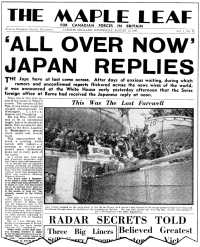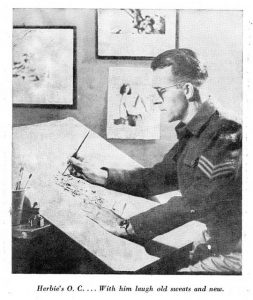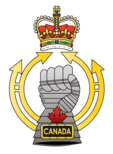Other than through daily orders, few soldiers had access to information from the outside world. Radios offered some access to the news of the day but for many soldiers, it was the service newspapers that provided information and a break from the monotony of the soldiers life.
There were different newspapers published for different countries, arms, and theatres. The most well known is “Stars and Stripes” produced in multiple theatres and with columns by both professional and amateurs. There were also “Springbok” (South Africa) and Fauji Akhbar (India). As well, many were theatre specific – Ceylon Review (Celyon), Parade (Middle East), and Guinea
 The Maple Leaf was the Canadian Service Newspaper from January 1944 until May 1946. Prior to that, Canadians in the UK could read the “Canadian Press News”.
The Maple Leaf was the Canadian Service Newspaper from January 1944 until May 1946. Prior to that, Canadians in the UK could read the “Canadian Press News”.
It was produced/edited by Captain J.D. MacFarlane later Major MacFarlane M.B.E of the Canadian Army Public Relations Group. Being a Service Newspaper, MacFarlane had independence from higher command but would not print news or opinions that might damage morale of the soldiers in the field.
The paper moved with the Canadian forces. Starting in Sicily, then Naples, Rome and onto Europe. In Europe, it moved as well starting in Caen, Brussels, Amsterdam, and finally Delmenhorst (German). A final edition ran from London from July 1945 to February 1946 for soldiers waiting to ship home from England.
Much like Bill Maudlin’s “Up Front” cartoons for the Stars and Stripes. The Maple Leaf acquired the services of William Garnet “Bing” Coughlin. He was born in Ottawa on 7 October 1905 and studied at Pennsylvania School of Industrial Art in 1923. In WW2, he returned to Ottawa and enlisted in the Princess Louise Dragoon Guards. With the PLDGs, Sargent Coughlin fought in Sicily and then in Italy where his talent was recognized by MacFarlane.
Coughlin’s main character was a Canadian infantryman named “Herbie” and was used to caricature bully officers and Germans. Herbie also ran in the Army Bulletin and 30 on-military newspapers. Several collections were printed after the war.
Coughlin was voted “Canadian Man of the Year” by the overseas troops and was made a Member of the Order of the British Empire in 1946.
Several of his original cartoons appear in the Worthington Archive.


By using this site, you agree to our terms and conditions.
Terms and Conditions.
Copyright
Contact us by email.
© 2020 Royal Canadian Armoured Corps Association
